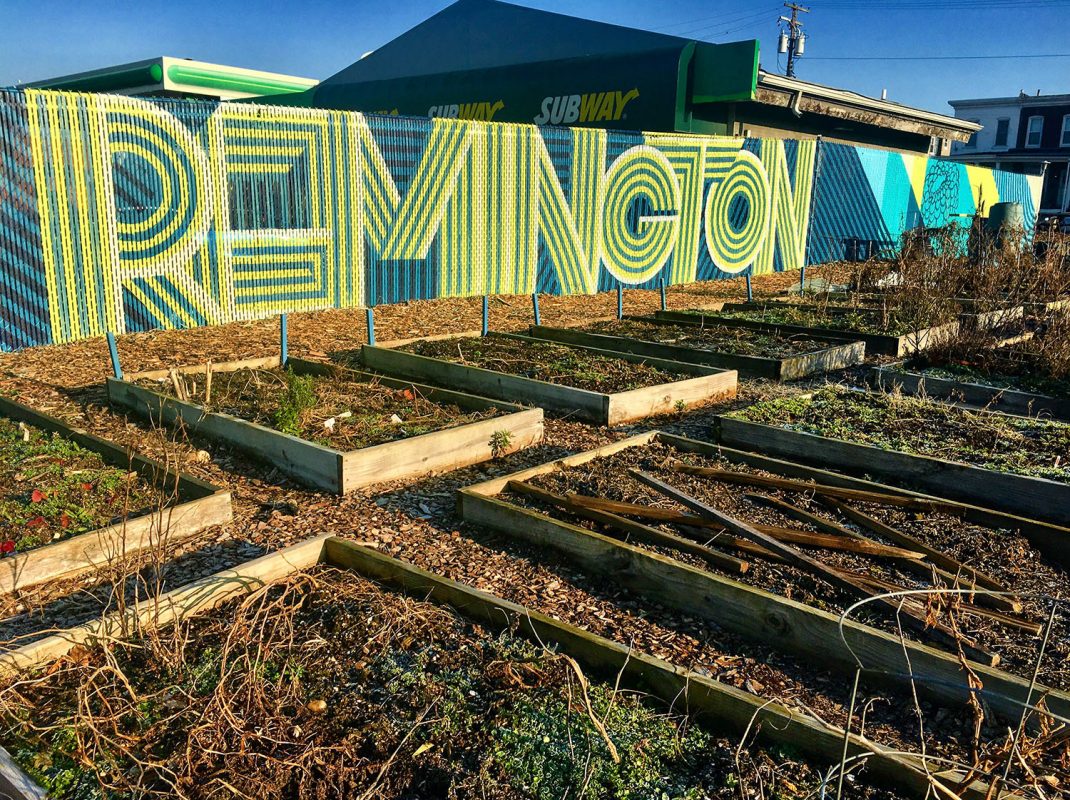
The once lifeless lot on the corner of Sisson and West 27th streets in Remington has come a long way since 2015, when the Greater Remington Improvement Association (GRIA) took over the property through the city’s Adopt-A-Lot program.
Since then, the vacant space full of untamed weeds and browning grass has transformed into a lively hub for community engagement. The park is now equipped with garden beds, picnic tables, an outdoor stage, play structures for kids, and—its most recent addition—a colorful mural commissioned by GRIA and funded by the Baltimore Office of Promotion and the Arts’ community art prize.
“It’s a really active site for our neighbors,” says Molly McCullagh, former GRIA president who has been overseeing the park project since the beginning. “And we want to continue to program it with them in mind. Creating the mural really helped to enliven the space even further.”
McCullagh had recently worked with local street artist Gaia to produce a series of portraits on blank walls around the neighborhood, but the Sisson Street canvases—a chain link fence and two repurposed shipping containers—made way for something more abstract.
“The fence and the shipping container are pretty unusual materials to mural,” she says. “So it made sense to add a lot of linear elements rather than portraits. There are so many organic shapes at the park, including plants and gardens, so we thought the balance of these linear, more geometric shapes would really create a nice juxtaposition.”
As it does with many of its initiatives, GRIA surveyed Remington residents to get their feedback on color and design. The result is an eye-catching piece by local artists Greg Gannon and Carol P. Jarvis, who also recently worked together on the striking exterior of the new Beyond Video store in Remington.
“There’s been a lot of community input,” Gannon says. “When you’re presented with a long wall like this, it really makes you think about what fits in the space and how you can use the mural site as part of its design.”
Featuring bright shades of green, blue, and yellow, the piece showcases a three-dimensional design that spreads throughout the 100-foot fence and continues the aesthetic on two shipping containers stationed throughout the park. The work also includes blossoming flowers and a line drawing of an alligator as a nod to the reptilian mural on West 28th Street by longtime local artist John Ellsberry.
“Everybody in the community loves that landmark, so we thought it would be nice thing to reference,” Gannon says. “I love the challenge of carrying this out in a clever way. Chain link fences are not one of Baltimore’s most charming features, but that’s the part that I’m most excited about—making this fence look so different that you wouldn’t even notice it surrounds the back of a gas station.”
Gannon’s sentiments also reflect the overall trajectory of the site since it was taken over by GRIA four years ago. McCullagh says that locals who remember the state of the park back then are constantly awed by the transformation.
“It provides inspiration for our whole community to see what you can do with something that didn’t seem like much of an asset to begin with,” she says. “With a lot of volunteer effort, fundraising, and creative thinking, we’ve been able to turn it into a great community space. That’s really empowering for neighbors to understand that they can have that control.”
